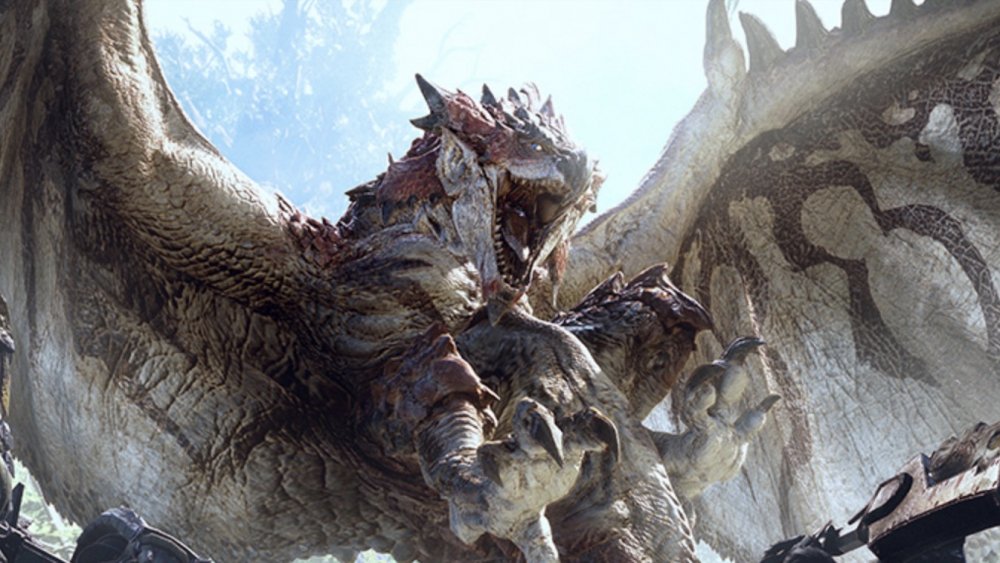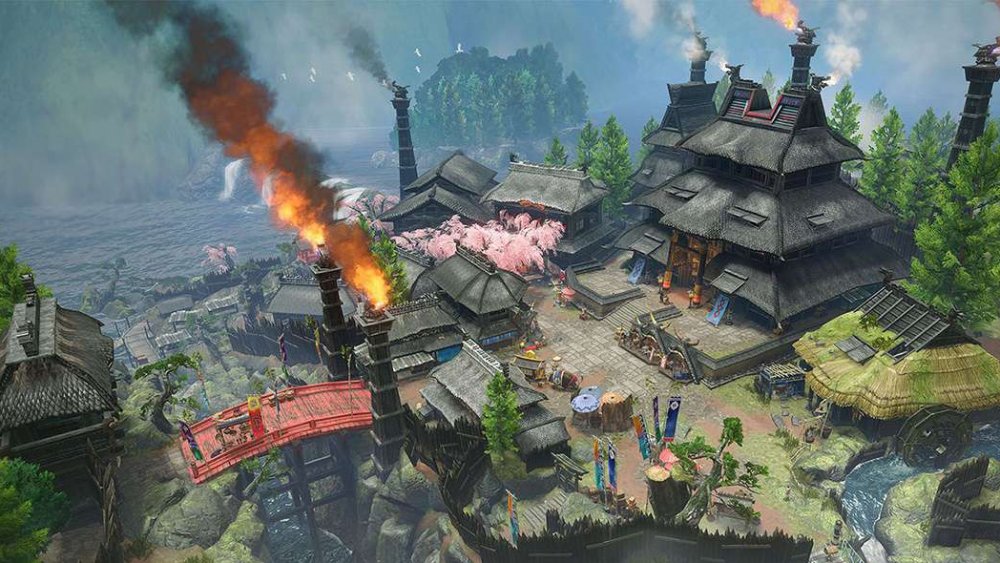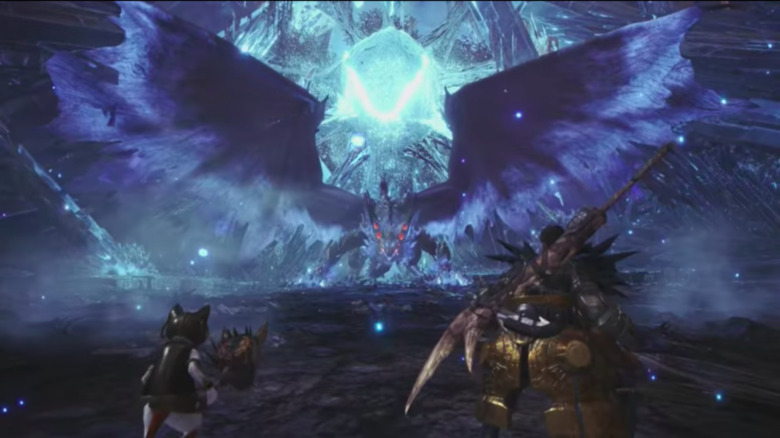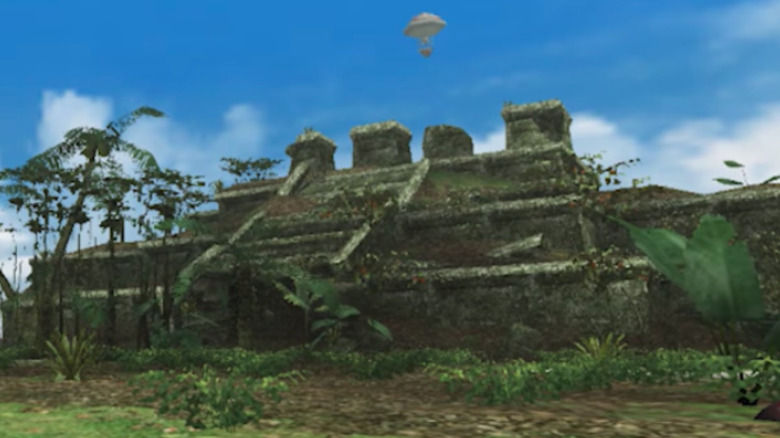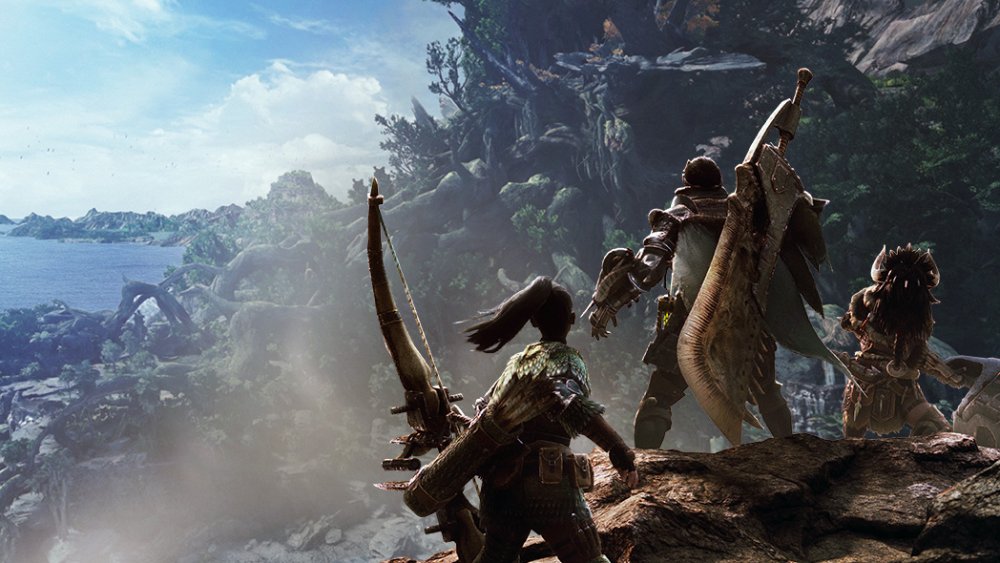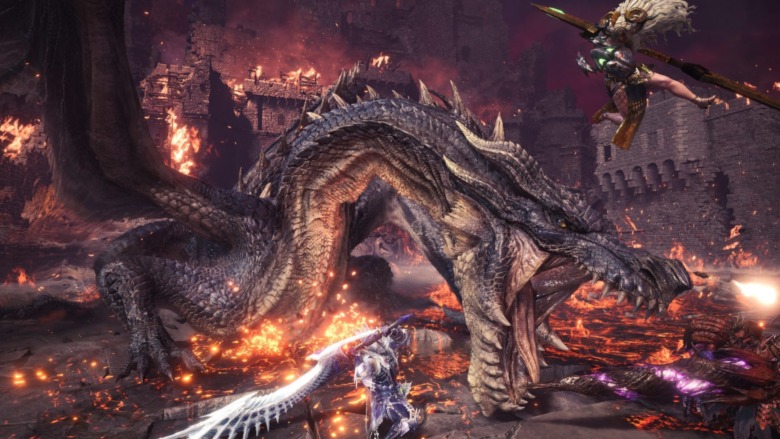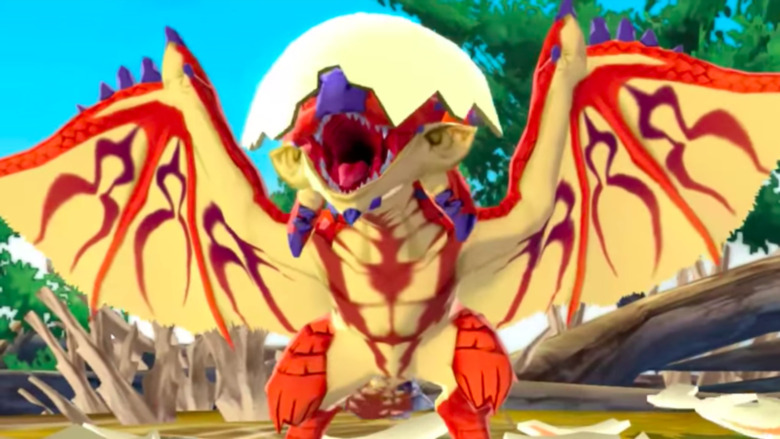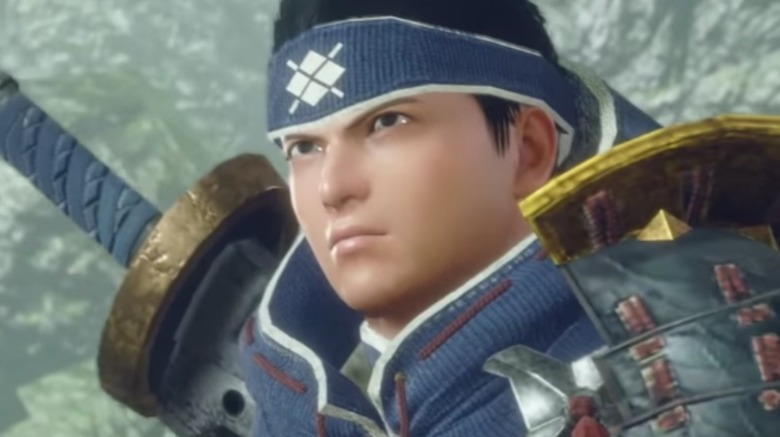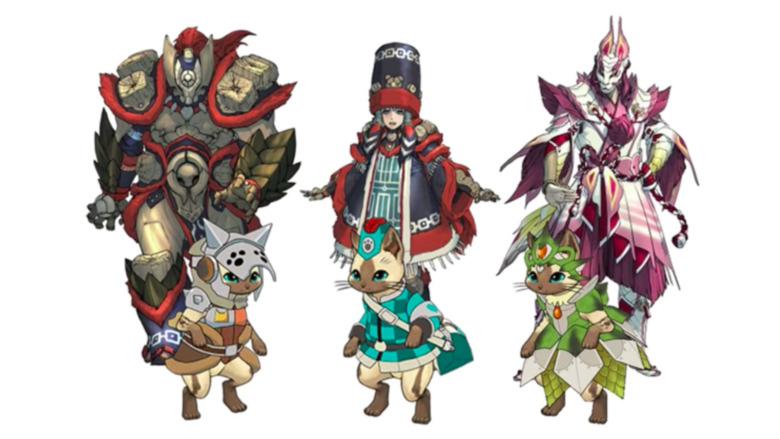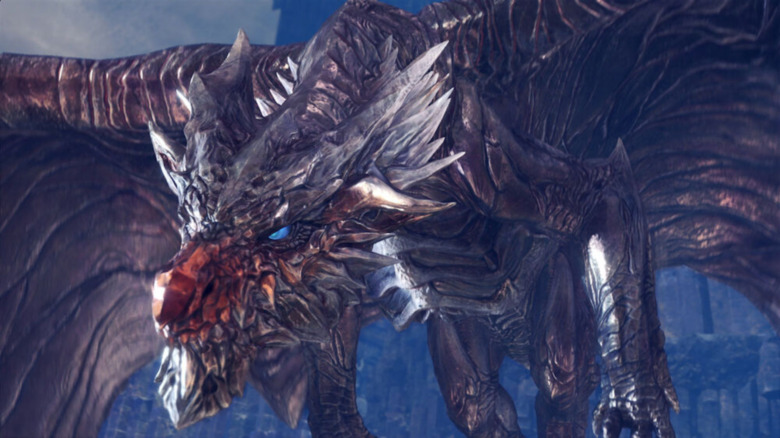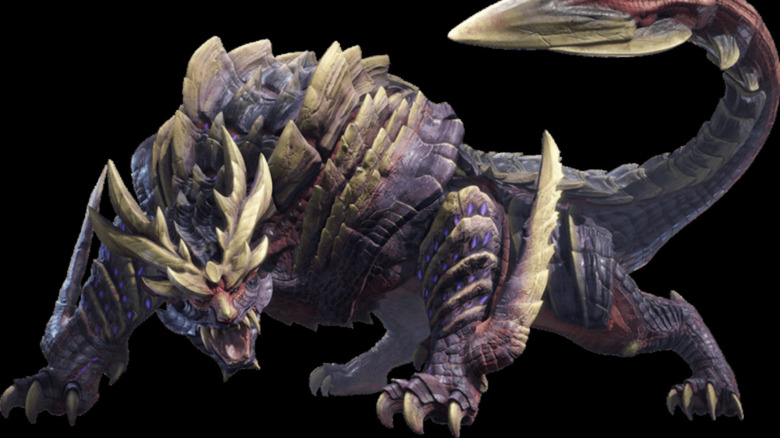The Mythology In Monster Hunter Explained
We may receive a commission on purchases made from links.
If you've played any of the games in Capcom's Monster Hunter franchise, you know it's a series that's less about creating a compelling story and more about grinding. You take out monsters, you harvest them, and you turn them into better gear. Although references to in-game lore are subtle and scarce, the series couldn't help but develop something of a mythology over the course of 16 years. However, the game's lack of focus on narrative means it can be a bit difficult to figure out the basics of the world you're exploring, especially without help from a community. These games were made to be played cooperatively, after all.
As you make your way through a Monster Hunter game, however, you do notice some things, such as the remnants of an ancient civilization. You realize that your weapons and armor are technologically much more advanced than the Stone-Age world around you — and that you can learn more about the world from reading the descriptions on your items. Plus, the monsters you hunt aren't just a part of the game, but help define the world you're living in. While large parts of this world are left up to interpretation and the franchise focuses much more on style than substance, there is definitely a dark underlying mythology worth exploring.
Monsters are an integral part of the world's creation
The world in Monster Hunter doesn't appear to have a name. Instead, players travel through regions within the Old World and the New World (the setting of Monster Hunter: World). According to a book you can find in your private suite in the home base of Astera in that game, the universe was originally inhabited by five dragons and one civilization of people. Time didn't start until the people started to question their eternal existence. When that happened, the dragons started to expel water, which made up the oceans and the sky.
One point this story makes is that beasts were involved in the creation of the world. They have been there since the beginning, and their importance to the world is paramount. Other folktales and children's stories in this world that explain the past have elevated the world's monsters to god status, which makes sense since dragons were involved in the creation myth that governs it. Many of the monsters have the word "God" in their names. Some, like the Elder Dragons, were even worshipped by the people, according to fan-collected information.
The Sapphire Star has both literal and metaphorical meaning
The Sapphire Star appears Tale of the Five as the form that one of the ancient dragons took when creating the world. It appeared in the sky as a shining, sapphire-blue star that guided "a lone youth" to the Island of the Five, where he received the dragon scales that helped humanity create the rest of the world.
In Monster Hunter: World, it's heavily implied that Xeno'jiiva, the campaign's final boss, is the actual Sapphire Star. Though it's never explicitly confirmed, the star the youth followed to the Island of the Five is hinted to be the meteor that brought the unhatched Xeno'jiiva to the New World. This theory is supported by the achievement you get upon slaying the unearthly dragon, which is likewise called "The Sapphire Star."
The meaning of the Sapphire Star runs deeper than new lore, however. Hunters often wish each other good luck on hunts by saying, "May the Sapphire Star light your way," a saying that's been adopted by the Monster Hunter fan community. The Sapphire Star in Tale of the Five served as a beacon that guided humanity to incredible power and gave them new life and purpose, and has since become a symbol of hope and promising new horizons.
The Ancient Civilization left behind incredible technology
The Ancient Civilization was a technologically advanced society that mysteriously went extinct long before the events of the Monster Hunter series. Very little is known about the people and their way of life, as the Hunter's Guild is only able to study their culture through the ruined remains of their once-great constructions.
The Ancient Civilization built ruins that can be found all over the world, including the Tower and the Sky Corridor (which actually made it into the Monster Hunter movie), as well as the pyramids found in the Flooded Forest. These ruins contained plans for advanced weapons like the Dragonator, which would go on to become part of the Guild's arsenal in defending their village homes against nearby monsters.
This technological prowess came at a cost, however. Hunters can find decaying scales scattered at gathering points throughout the ruins, suggesting that many of the magnificent buildings were constructed using monster parts. While Hunters are no strangers to using monsters for their weapons and armor, the Ancient Civilization would have needed far more monster parts to support their creations.
This is a post-apocalyptic world
While fans find it unclear from the games exactly what happened, you're clearly traversing a post-apocalyptic society. What happened?
The games do not provide an answer, so players have extrapolated based on a piece of concept art that purportedly appears in the book Monster Hunter Illustrations from Udon Entertainment. The book page indicates that the Equal Dragon Weapon is the only remaining weapon of war from the Great Dragon War, and is pieced together "from parts harvested from over thirty mature dragons."
Basically, the ancient civilization used dragons as building materials for this weapon, as it did for many of its other creations, and apparently used the weapon against them to boot. This resulted in the war that ended the previous age. However, note that this particular bit of history, while evocative, is not necessarily considered canon. Also, different Monster Hunter games and supplementary materials can be contradictory.
Still, there are a few things that can be pieced together regarding the Great Dragon War.
The Great Dragon War tore the world apart
The Forbidden Act — in which the ancient people fused tech and nature to create new monsters — is what finally took things too far. Horrified at the actions of the Ancient Civilization and the continued slaughter of their brethren to support their abominations, the dragons rose up against their oppressors with the intent of wiping them off the map.
The war between dragons and humanity raged for years, with dragons fighting to remind the Ancient Civilization of their place in nature, and the Ancient Civilization using their terrible creations to hold onto the power they'd obtained. Many of the details of the Great Dragon War have been lost to the ages, as the conflict resulted in the downfall of the Ancient Civilization and the near-extinction of the dragons.
During the war, there also existed a great enemy in the form of the black dragon Fatalis. It used its incredible power to demolish entire kingdoms in revenge, even mocking the Ancient Civilization's use of dragons by melting humans onto its own body as armor. The Legend of the Black Dragon states that when wyverns fill the skies again, Fatalis will return and bring its rage and destruction with it.
Some villages befriend monsters instead of fighting them
Following the Great Dragon War and the fall of the Ancient Civilization, the world persists in a state of abandonment and ruin. Civilization still exists, but primarily in small, mostly-isolated pockets. Hunters frequently arise in small villages that have no other means of protection from the monsters that surround them, but their methods of dealing with said monsters can vary wildly.
Hunting is common, and is generally done sparingly to protect the villagers and their livelihoods. The severity of their quests range from defending supply lines to taking down environmental threats, and there's always a level of fear and respect between the Hunters and their adversaries.
Some villages, however, have learned to live in peace with the local wyverns. For example, the Riders of Monster Hunter Stories live side-by-side with their monsters as companions and friends. Their interactions have changed vastly since the days of the Ancient Civilization, and hint to a future where humans and monsters can live in widespread harmony.
Hunters may not be human
The Hunters are the playable characters of Monster Hunter. They're powerful warriors capable of wielding massive weapons against their foes, falling great distances, and taking huge hits from their prey. It's unclear where the Hunters get their incredible strength and constitution from, as their abilities aren't shared by all humans in the Monster Hunter universe. Because of this, many fans speculate that Hunters aren't actually human at all.
Some believe that the Hunters are a mixed breed — that they're part human and part Wyverian, a race of people rumored to be descended from wyverns themselves. They physically resemble humans, but have an entirely different culture (and possibly even abilities) that humans don't fully understand. Wyverians were the first Hunters themselves, so it's not a stretch to think modern Hunters carry some of their blood.
Others still believe that Hunters aren't naturally occurring, and are the descendants of superhumans, bred for war by the Ancient Civilization during the Great Dragon War. It's certainly a much darker explanation for their abilities, but one that can't be discounted, especially given the history of humanity's interactions with monsters.
Felynes aren't actually cats, either
In some series entries, Hunters are often accompanied by Felyne friends known as Palicoes. They act as hunting buddies on quests, helping their partner by gathering materials, offering healing buffs, and dealing a bit of extra damage to the monster. In Monster Hunter Generations, they could even go out into the field on their own as Prowlers.
These creatures resemble cats, but they're not actually anthropomorphic kitties. Felynes are part of the Lynian race, which includes other cat-like critters such as Melynxes and Grimalkynes, but also the more ape-like Gajalakas, Shakalakas, and Boaboas. In fact, the Monster Hunter Encyclopedia shows that early concept art for the Felynes was much more goblin-like than their final appearances.
While Palicoes aren't actually cats, there's no indication that Monster Hunter Rise's new Palamute partners aren't dogs. They're intelligent enough to use weapons and can carry the weight of a Hunter in full armor as they run, but they don't seem to be sapient in the same way Felynes are. Fans have yet to see official lore about Canynes, so their place in the Monster Hunter mythology remains to be seen.
Elder Dragons control the natural environment
Elder Dragons are the endgame monsters in Monster Hunter. They're preceded by their reputation as terrifying creatures far beyond the might of the wyverns that usually plague Hunters and their villages. They're among the last few true dragons left after the Great Dragon War, and bear all the might of their furious ancestors.
Elder Dragons often boast extremely powerful elemental abilities, to the point that Monster Hunter World refers to them as "living, breathing forces of nature." The Elder Crossing, an event in which aging Elder Dragons travel to the New World to ultimately die in the Rotten Vale (a massive dragon graveyard), is capable of corrupting an entire ecosystem just by having so many powerful Elder Dragons in the same place at once. Finding them alive and well and wreaking havoc in the world, is another matter entirely.
Dragons like Kushala Daora are capable of creating massive gusts of wind, Vaal Hazak can corrupt other monsters with its effluvia, and Alatreon can manipulate enough elements to start several different natural disasters at once.
Monster Hunter Rise takes inspiration from real mythology
It takes only one look at Monster Hunter Rise to see the inspiration it takes from feudal Japan. From the architecture of Kamura Village and locations like the Shrine Ruins to the colorful dango Hunters can buy before their hunts, the game is full of elements that embrace the era and culture.
The inspiration is visible in the monsters, as well. Though there are plenty of familiar faces returning from earlier Monster Hunter games, there are a handful of newcomers that seem to emerge straight from Japanese folklore. According to a Wired interview with MHR director Yasunori Ichinose, many of the game's wyvern designs reference Japanese oni (demons) and yokai (spirits), combined with a special twist that makes them unique to their game.
Creatures like Tetranadon and Aknosom are based on the kappa and kasa-obake yokai, respectively. The Great Izuchi is based on the kamaitachi down to its moveset, which mimics the yokai's whirlwind speed and tendency to roam in packs of three. While the game's flagship monster, Magnamalo, is not based on any specific spirit, it does take a lot of visual inspiration from samurai armor.

